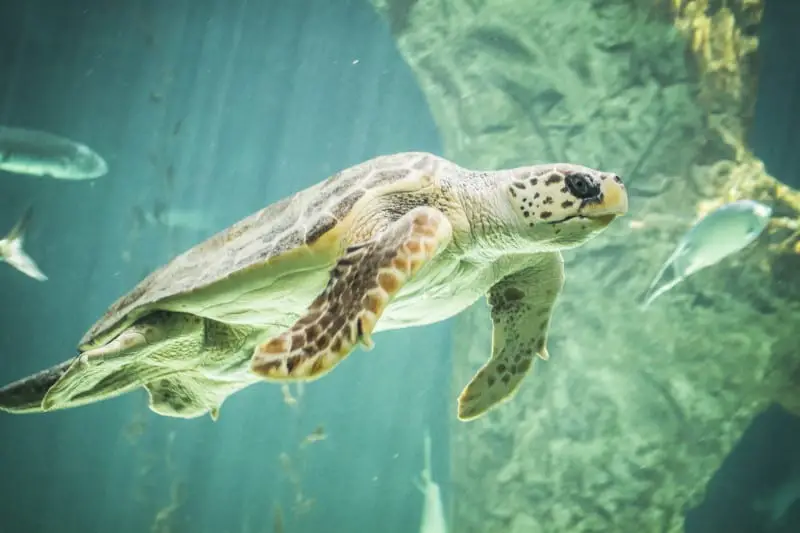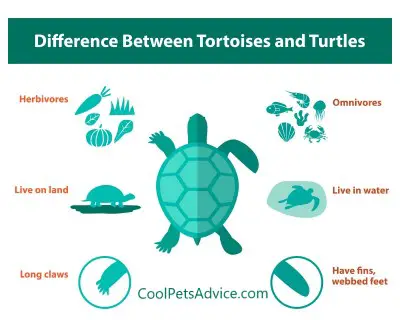Some people find it hard to tell tortoises and turtles apart. In fact, it can be unclear to know which one is adept at swimming and which one stays on land in the same light.
Turtles and tortoises have certain physiological features to help them live in either water or land. For instance, water turtles have flippers or webbed feet to help propel them while in water, as tortoises have strong, short limbs to travel on land.
We will aim to assist in differentiating tortoises from turtles and tell you which one is the better swimmer. We’ll also bust the myths associated with the two to eliminate the confusion. Read on as we delve deeper into the world of these two majestic creatures.

How Come Turtles Can Swim but Tortoises Can’t?
It may be difficult to tell the two reptiles apart, given that they are very similar in appearance. To differentiate them, you may have to take a closer look. However, the main difference is that the turtle is a prolific swimmer, choosing to stay on land occasionally; let’s find out why it thrives in the water, unlike the tortoise.
Turtles are naturally great swimmers, thanks to their feet’ shape, shell nature, and habitat. Their feet are webbed or flattened and specially modified to help propel them while they travel in water. Tortoises on the other hand have elephant-like feet, suitable for traveling on land. Secondly, turtles have light, streamlined shells enabling them to swim, while the tortoise’s shell is larger and heavier, which grounds them to land. Lastly, the turtles’ natural home is close to the ocean. Hence, they find it easier to swim and conduct all their activities while in water, unlike the tortoises.
The following is a detailed look at the physiological and other reasons why the turtles can swim better than tortoises.
The Feet
Turtles and tortoises have different limbs, each adapted to its function. Instead of feet, turtles possess flippers or webbed limbs, which act like a fish’s fins. While sea turtles have flippers, freshwater turtles have webbed feet. Although these limbs are specially modified for swimming, the turtles can occasionally travel on land. They can travel for a long distance, but their walk is quite clumsy. It’s rare to spot them on the ground unless it’s the brief moment when hatchlings rush to the sea or when mother turtles go to lay eggs.
On the contrary, tortoises have solid feet, similar to that of an elephant. Being thick, sturdy, and bowed, these legs help them easily travel across the land even when the ground is rough. Such limbs are not the best for swimming since they cannot assist in propelling them in water. This physiological difference is why the tortoise would rather stay on land and not the sea.
The Shell
The two reptiles’ shells strongly determine their swimming capabilities. A turtle’s shell is light, streamlined, and flat, making it effective for sea travel, while tortoises have heavy and curved bodies, hindering effortless swimming. Whenever they are in the water, their armor weighs them down, and they find it hard to move their limbs in the water.
On the other hand, the turtle’s shell shape is well-designed to allow water to glide smoothly on top and cut through as they swim, thereby lowering the drag. Incredibly, turtles can shed off their scutes as they get older to prevent their shells from bulging outward like tortoises’. With this, they can maintain their flat, light armors.
The Habitat
An animal’s habitat dictates its way of life. If a turtle was born and spent a significant part of its life close to water, it will naturally be adept at swimming. Similarly, if a turtle lives in a dry area, it won’t be a great swimmer. Some turtles, like the box turtles, are not excellent swimmers like other turtles.
Since turtles’ habitat is close to large water bodies, they have naturally evolved to become excellent swimmers and stay long underwater. They can also swim for a long time while holding their breath and not get tired in the process. Some turtles like the painted turtles can even stay for months during brumation when the temperatures are freezing.
For tortoises, their large feet and shells are only suitable for living on land. Given how slow they are, they need large armors to protect them from predators. As a result, they cannot swim fast in the water or hold their breath to help them go underwater. They will only try to swim if they have to. If they do, the chances are high that they may drown.
Do Turtles Have To Stay in Water?
Most don’t know that tortoises are also turtles, only that they live on land; freshwater turtles, land turtles, and sea turtles are all Testudines. Read on as we aim to determine whether sea and freshwater turtles can stay on the ground although they belong in the water.
Water turtles spend a significant part of their lives in water, with most species hardly coming to land unless the females are laying eggs, which happens at least once a year. You can also rarely spot a few who wish to bask on the beach since most of them would rather stay in the water bodies. However, some species like the snapping turtles can occasionally walk for miles on land when searching for a new water body. Other species like the box turtles even spend a lot of time on the ground, only rarely getting into the water.
In contrast, other turtles like sliders and painted turtles are highly dependent on water only to eat when submerged. The wood turtle species is one of the few that can hunt on land and when submerged. Since their limbs are best suited for swimming, their walk is somehow clumsy, and they seem to struggle to balance. Thus, a turtle’s ability and duration to stay out of water entirely depend on its species.
Is a Tortoise a Great Swimmer?
Different tortoise species behaviors differ when put in a water body due to varying swimming abilities. They all love to play and soak in the water, but not for a long time like the turtle.
Tortoises’ bodies aren’t designed for swimming; thus, they are not perfect like turtles. They only go near water bodies when bathing or when regulating their temperature. Their limbs are clawed and bent, making them adapt to land-living instead of swimming. Since they are poor swimmers, wild tortoises will always avoid the deep end of any water bodies. If it accidentally falls into a large water body, it must formulate survival tactics to get to safety. Hence, a tortoise can float, drift and hold its breath for a while, depending on its size. Smaller reptiles can’t go without air for long, making it easy for them to drown.
By sheer luck, a light tortoise can reach the water’s shallow end and get safely ashore with the help of fast-moving water. Therefore, even when you provide water to dip in, it is wise to place the water in a shallow dish; otherwise, juveniles can submerge and even drown. Your tortoises are safe if the water is enough for them to walk over, and they will be more at ease if they are confident that the water is not a drowning hazard.
Tortoises are poor swimmers, only able to survive in water by chance. In contrast, other species like leopard tortoises can float and even swim better than other tortoises. They have a large dome-shaped shell with enough lung space to facilitate buoyancy. A tortoise is likely to drown when it stays submerged for too long or if it tries to swim across a large water body. It may survive when crossing a small pond, but the chances are rather slim when it finds itself in an ocean.
Fortunately, depending on the tortoises’ age, they can hold their breath for long. If mature, some species can stay for up to twenty minutes while in water as they drift and follow the water currents trying to catch a safe ground. Once they deplete the air reserves before making it ashore, the tortoises may drown.
If your pet drowns while inside the tub, you can revive it before its body gives out; expert attention at the nick of time may bring it back. You can try first aid options as you wait for the vet to arrive. These methods include holding the reptile upside down while pressing its flanks or giving mouth-to-nose resuscitation by forcing air into his nostril to expand the lungs.
Finally
Tortoises are naturally meant for life on land and not in water like the turtles. Their legs are broad and short, making it tasking for them to swim. Similarly, their shells are heavy and dome-shaped, which makes them drag when trying to swim. It is also difficult for them to hold their breath while in water. Hence, it is easy for them to drown when in large water bodies.
However, the inability to swim doesn’t stop them from frequently drinking and dipping in water, as long as it’s shallow. Therefore, it is best to keep a close eye on your tortoise since it can quickly submerge and drown.
Read more:

![Can Box Turtles Swim? [Truth Revealed] Can Box Turtles Swim](https://coolpetsadvice.com/wp-content/uploads/2021/05/Can-Box-Turtles-Swim-400.jpg)






